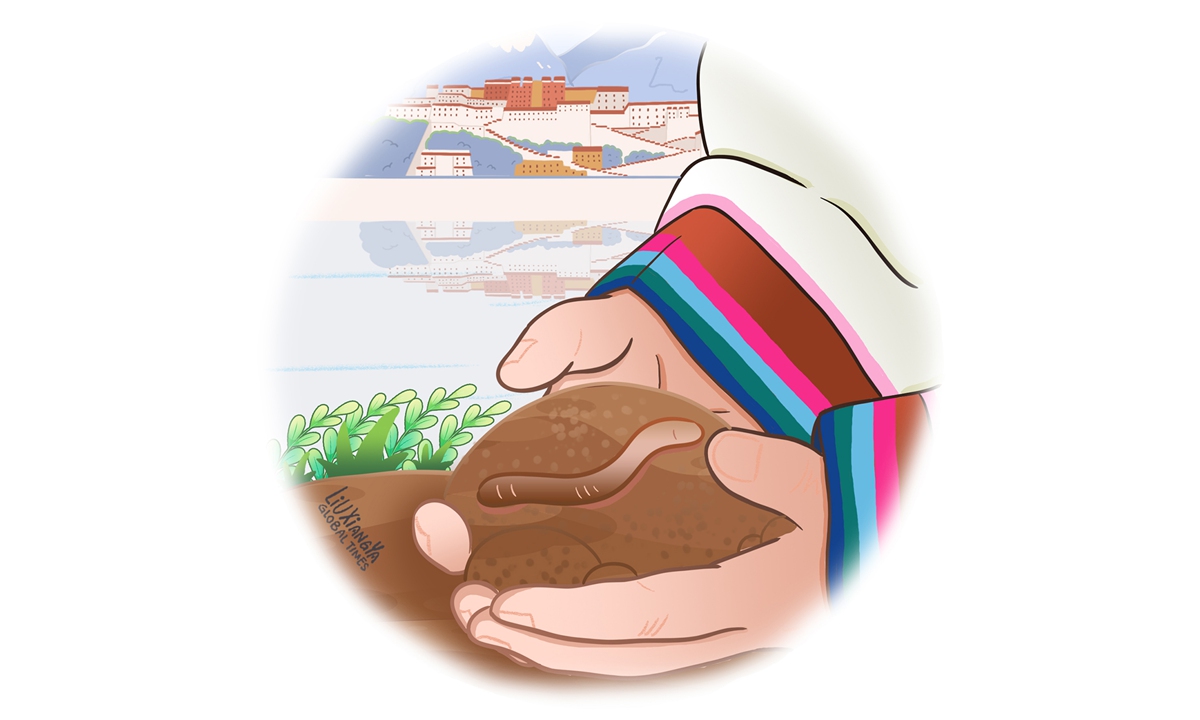ARTS / CULTURE & LEISURE
Cherishing life permeates Tibetan culture

Illustration: Liu Xiangya/Global Times
Sichuan is experiencing light rain as Wu Lian walks on her way to work. Meanwhile, the earthworms emerging from the muddy ground along the road are also undergoing a migration.However, some earthworms are getting stranded on the cement pavement. At moments like these, Wu Lian picks them up one by one and places them back into the soil, despite her hands getting covered in mud.
"Otherwise, they could easily be stepped on by passersby," she says. This unique habit stems from her trip to Lhasa, capital of the Xizang Autonomous Region, three years ago.
This "Earthworm Rescue Operation" is a very unique manifestation of the spirit of cherishing and protecting life that the Tibetan people have continued for centuries.
Near the Potala Palace, in the vicinity of Zong Juelu Kang (Dragon King Pond), during the rainy season, you can see people of all ages bending down to gently pick up earthworms that haven't been able to complete their journey and placing them back onto the grass.
This is because once the sun comes out in Lhasa, the worms quickly lose moisture and face danger. Some local children even take the initiative to inform unaware tourists to watch their step. Of course, this isn't just about rescuing earthworms; it's just that because earthworms are particularly fragile and inconspicuous, such a scene arises.
Even today, many Tibetan people still recite a protective mantra when drinking water, intending to liberate the microorganisms in the water about to be consumed. And they will tell their grandchildren the story of this small ritual like a tale.
Similar to how the Han people usually call for compassion for even the tiniest of ants, Tibetans start from rescuing earthworms. This custom originates from the core doctrine of "equality of all sentient beings" in Tibetan Buddhism.
Carried on to the present day, it can be said that rather than merely being a religious tradition, it has long been internalized as a guiding principle in the daily lives of ordinary people.
Another story is about the origin of the Shoton Festival. Before the 17th century, the Shoton Festival was a primitive religious celebration.
According to folk tradition, as the weather warmed in the summer and all living things revived, monks going out for activities would inadvertently harm living creatures, violating the precept of "do not kill."
Therefore, the Gelug sect's monastic rules stipulated that from the fourth to the sixth month of the Tibetan calendar, monks could only recite scriptures and practice in the temples.
On the day the ban was lifted, monks would leave the temples and descend from the mountains. To thank the monks, local residents would prepare yogurt and organize outings and feasts, including traditional Tibetan opera performances, to celebrate the occasion.
It can be said that the practice of loving and protecting life is the starting point of the socialization process for Tibetan children. Life is adorable, life is respectable.
Tibetans believe that one should do everything possible to avoid harming any life. If there is truly no choice, then one should still hold an attitude of respect and gratitude.
Such beliefs permeate through people's daily lives, in the cycles of seasons, and in their daily activities.
The fundamental principle that every newborn baby first learns is a profound empathy toward the existence of any life. As an extension of this spirit, Tibetans often exhibit the utmost compassion toward the weak.
The essence of compassion includes, but is not limited to, "tolerance." Its broader meaning encompasses acknowledgment, empathy, and an emotionally driven commitment to action.
In Xizang, during feasts, not only were beggars not driven away, but they were also treated as honored guests.
Even in contemporary urban life, Tibetans are still able to treat all members of society more equally. On this land, the quality of being "snobbish" is disliked by everyone.
Faith is not confined to temples but also ingrained in everyday activities. When we talk about culture, it is never limited to external forms like singing, dancing, or intricate artwork.
The local people's outlook on life has gradually extended beyond the region with the opening up of Xizang.
Therefore, when you hear tourists from other regions or countries expressing admiration for how Tibetan culture has purified their souls, it is likely not an exaggeration.
The author, a PhD, is a lecturer at Hunan University. life@globaltimes.com.cn


